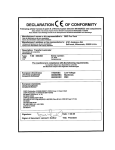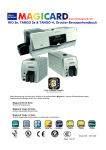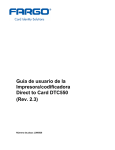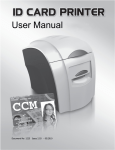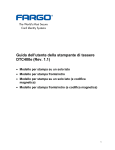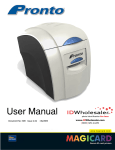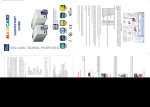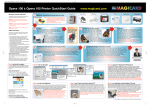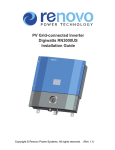Download plastic card glossary - International Plastic Card Corporation
Transcript
Plastic Card Terminology
A
Access Control - An implemented system that controls access to buildings or rooms within
buildings. Plastic cards (e.g., those with magnetic stripe or proximity control technologies) can be
used to gain access to premises.
B
Barcode - A code consisting of a group of printed and variously patterned bars and spaces, and
sometimes numerals that are designed to be scanned and read into computer memory as identification
for the object it labels.
One-dimensional - (1-D, linear) A barcode consisting of a single row of bars. 1-D barcodes
store a smaller amount of data than two-dimensional barcodes and are therefore more suited for
applications in which only a few characters are stored. 1-D barcodes store their data in the
horizontal width and the information stored is highly redundant. They are therefore more resistant
to data degradation. An example of a 1-D barcode is Code 39.
Two-dimensional - (2-D) 2-D barcodes store more information than 1-D barcodes and take
advantage of both their horizontal and vertical dimensions to do so. An example of a 2-D barcode
is PDF417.
Barcode Mask - Is an area on specially-made cardstock where a barcode can be printed that will
prohibit unauthorized copying of the barcode. ID Wholesaler carries red and black barcode mask
cardstock.
Biometrics - Utilizes "something you are" to authenticate identification. This may include a
fingerprint, DNA, retinal pattern, iris, hand geometry, vein pattern, voice password or signature
dynamics. Biometrics can be used with a smart card to authenticate the user. The user's biometric
information is stored on a smart card, the card is placed in a reader, and a biometric scanner reads the
information to match it against that on the card. This is a fast, accurate and highly-secure form of user
authentication.
Bluetooth - A short range radio technology aimed at simplifying communications among Internet
devices and between devices and the Internet. It also aims to simplify data synchronization between
Internet devices and other computers.
C
CR79 Card - Slightly smaller dimensionally than CR80 cards; made to fit in the well of a proximity
card. Dimensions are 3.303" x 2.051" (83.9 mm x 51 mm).
CR80 Card - Standard card size; CR80 card dimensions are 3.375" x 2.125" (85.6 mm x 54 mm).
CR90 Card – Driver's license size; slightly larger than the standard CR80, CR90 cards are 3.63" x
2.37" (92 mm x 60 mm).
CR100 Card – Often referred to as oversize or military-sized cards, CR100 cards measure 3.88" x
2.63" (98.5 mm x 67 mm).
CardJet Card - Fargo Electronics, Teslin-based CR80 size cards exhibit a surface that is specially
formulated for thermal inkjet printing. CardJet inks bond to cards and dry instantly, without
smearing. CardJet cards stand up well to abrasion, dye-migration and UV fading.
© International Plastic Card Corporation P/L - 1992 - 2015
CardJet Printing - Discontinued printing technology by Fargo / Fargo Persona that uses an HP
inkjet-based print engine to transfer color and monochrome inks onto specially formulated CardJet
cards. This particular inkjet printing process involves heating the inks within an ink cartridge. This
heat generates vapor bubbles that are ejected in tiny droplets through nozzles in the ink cartridge.
These droplets form text and images on the printable card surface which then bond and dry instantly.
Magicard has developed advanced solutions.
Card Dispenser - A container used to store blank cards to keep cards free from dust and debris.
Chip - A piece of semi-conducting material (usually composed of silicon) on which an integrated
circuit is embedded. It is fitted inside an ID card that is used to store user information and access
privileges; also provides added security to prevent card counterfeiting.
Cleaning Card - Its purpose is to assist in keeping a card printer clean and to maintain the key parts
of the printer including the printhead, transport rollers and magnetic encoding station. Some card
printer manufacturers (e.g., Magicard) recommend cleaning the printer with a cleaning card each time
the ribbon is replaced.
Cleaning Roller - Consists of an adhesive surface that picks up debris from blank cards. Some card
printer manufacturers (e.g., Magicard) recommend replacing the cleaning roller after every 1000
prints or sooner.
Cleaning Tape - Is a roll of adhesive-lined material and its purpose is to pick up debris from blank
cards prior to printing.
Combination Card - (Combi card) Combines both contact and contactless chip technologies, using
two different chips.
Contact Smart Card - Contains a single embedded circuit chip that contains memory, or memory
plus a microprocessor. Contact smart cards must be inserted into a card acceptor device where pins
attached to the reader make "contact" with pads on the surface of the card to read and store
information in the chip.
Contactless Smart Card - (Proximity card/prox card) Contains a chip that is connected to an
antenna (rather than contact pads as in contact smart cards). The communication between the chip
and the reader is therefore wireless.
Cut and Paste - Refers to the very manual and outdated process of creating ID cards. This process
involves taking a photo, manually cropping it and sticking it onto a card and then laminating it with a
thermal laminator.
D
DPI - (Dots per inch) Measurement of a printer's resolution. For example, 600 DPI indicates that the
printer can produce 600 dots of color in each inch of a card. NOTE: When judging color
reproduction for a CardJet card printer, the inkjet resolution must be at 2400 DPI or better to achieve
the color equivalent of a 300 DPI dye-sub printer.
Database ID Software - Software that allows the saving and storage of cardholder records and data.
Debitek (Debit) Stripe - Also referred to as a 'junk stripe' because it is often used for purchases from
candy vending machines. Debit stripes are generally encoded at 4000 Oersted. Because the stripe is
thinner (1/8") than the standard Hi Co or Lo Co coercively magnetic stripe, it can only contain
information specifically for use with the debit system.
© International Plastic Card Corporation P/L - 1992 - 2015
Digital Camera - A camera that records images in digital form. Unlike a traditional analog camera
that records infinitely variable intensities of light, a digital camera records discrete numbers for
storage on a flash memory card, for example. There is a fixed, maximum resolution and number of
colors that can be represented. Images are transferred to a computer with a USB cable, memory card
or wireless.
Digital Imaging - Scanning or otherwise capturing images which may be subsequently edited, filed,
displayed or printed on a plastic card.
Direct-to-Card Printing - (DTC) This process involves the printing of digital images directly onto
any plastic card with a smooth, clean, glossy PVC surface.
Dual Interface - Combines both contact and contactless chip technologies, using the same chip. The
chip is connected to the contact pad on the top of the card and the antenna inside the card.
Duplex - (Dual-sided) Capable of printing on both sides of a card, usually in a single pass.
Dye Sublimation - (Dye diffusion, dye-sub) The print process ID card printers use to print smooth,
continuous-tone and photo-quality images. This process uses a dye-based ribbon roll that is divided
into a series of color panels. The color panels are grouped in a repeating series of three separate
colors along the length of the ribbon: yellow, magenta, and cyan (YMC). As the ribbon and card pass
simultaneously beneath the printhead, hundreds of thermal elements heat the dyes on the ribbon.
Once the dyes are heated, they vaporize and diffuse into the surface of the card. Varying the heat
intensity of each thermal element within the printhead makes it possible for each transferred dot of
color to vary in saturation. This blends one color into the next. The result is continuous-tone, photorealistic color images.
.
E
Edge-to-Edge - (Edgeless/over-the-edge) Refers to the maximum printable area on a card. Printers
with edge-to-edge printing capability can print just to the edge of a card resulting in printed cards
with virtually no border. Nearly all brands print standard CR80 cards edge-to-edge.
Encoding - The process of electronically "writing" information on magnetic stripes or into a variety
of smart card types. Holds information such as card holder details and access privileges.
Ethernet Interface - A local area network (LAN) architecture that supports data transfer at varying
speeds.
F
Fingerprint Reader - (Fingerprint capture device, fingerprint scanner) A form of biometrics
technology in which a scanner is used to identify a person's fingerprint for security purposes. After a
sample is taken, access is granted if the fingerprint matches the stored sample.
Fire Wire - (IEEE 1394) High speed external connection used for connecting peripherals.
Font - A character set (alphabet and numerals) of a specified design and size.
H
Half Panel YMCKO Ribbon - Consists of half of the normal yellow (Y), magenta (M) and cyan (C)
color panels, but full panels of the black (K) and clear overlay (O). The objective of this ribbon is to
allow twice the normal ribbon yield than the standard YMKCO ribbon at a lower cost per card.
YMCKO half panel ribbon is ideal for cards when a color ID picture is needed, along with some
background black resin text, logo or barcode printing. Practical applications include student ID cards,
© International Plastic Card Corporation P/L - 1992 - 2015
employee ID cards and driver's licenses. Refer to Evolis' YMCKO half panel ribbon for more
information.
High Coercivity - (HiCo) Magnetic coding on a magnetic stripe. HiCo stripes are encoded at 2750
Oersted. HiCo stripes are generally black and store information on a more secure basis than low
coercivity magnetic stripes, due to the higher level of magnetic energy required to encode them.
Information is harder to erase on HiCo cards; therefore, they are common in applications where cards
are swiped often and require a long life (e.g., credit card applications).
High Volume Printing - (High throughput) Fast, efficient printing for producing large quantities of
cards with minimal downtime for supply loading or maintenance.
High Definition Printing - (HDP) This process prints full color images onto clear HDP transfer film.
The HDP film is then fused to the card through heat and pressure via a heated roller. This
revolutionary technology enhances card durability and consistently produces the best card color
available - even on tough-to-print matte-finished cards, proximity cards and smart cards.
Hologram - A unique photographic printing that provides a three dimensional (3D) effect on a flat
surface; usually applied to ID cards as a laminate but can also be built into blank card stock.
Holograms cannot be easily copied and are used for visual security and aesthetic purposes on cards.
HoloKote - A unique Magicard patented card watermark technology, where Magicard ID card
printers print a HoloKote watermark into the card overlay layer during printing. (See sample card
with both HoloKote and HoloPatch features.)
HoloMark - A tamper-evident, instantly verifiable 3-D image in a high resolution hologram
embedded onto a card. Fargo standard and custom HoloMark cards provide an added level of
protection against ID counterfeiting. For use with Fargo Direct-to-Card (DTC) series card
printers/encoders. (See sample custom HoloMark cardstock.)
HoloMark Seal - A Fargo-brand peel-and-stick 3-D seal that if removed from a card, is not reusable.
A checkerboard pattern will appear to indicate both the card and the seal have been tampered with.
The HoloMark seal is a quick, economical way to augment the security of an existing card.
HoloPatch - A unique Magicard visible gold patch built into blank card stock; HoloPatch works with
HoloKote to highlight one of the HoloKote watermarks, providing daylight-visible ID card security.
(See sample card with both HoloKote and HoloPatch features.)
Hopper - Input and output hoppers hold card stock as they are fed and ejected from the ID card
printer.
I
Inkjet Printer - A printer or an all-in-one unit that ejects fast-drying ink through tiny nozzles onto a
page to form characters. The inkjet is currently the standard for personal computer printing. Inkjets
are fast, affordable and relatively quiet; they provide high quality graphics, and print in color.
Interface - A connection standard for transferring data that is recognized by all PCs or Macintosh
computers. For example, a parallel printer port is a common interface found on virtually all PCs for
transferring data from the computer to a printer. Other interfaces include USB and ethernet.
International Organization for Standardization - (ISO) In the ID card printing industry for
example, ISO defines specifications for magnetic stripe encoding. Printer encoders generally support
dual high/low coercivity and tracks 1, 2 and 3. Refer to printer specifications.
© International Plastic Card Corporation P/L - 1992 - 2015
J
JIS II - Japanese Industrial Standard for magnetic stripe encoding. JIS II is published and translated
into English by the Japan Standards Association.
K
Key FOB - A security token that can be attached to a keychain.
L
LCD - (Liquid crystal display) Shows the current status of a printer, and changes according to the
printer's current mode of operation. LCD communicates with text.
LED - (Light-emitting diode) Shows the current status of a printer, and changes according to the
printer's current mode of operation. LED communicates with a blinking light.
Lamination - (Overlamination) The process of combining lamination material and core material
using time, heat and pressure. Available in clear or holographic designs and in varying thicknesses,
laminate patches used in card printers come on rolls, with and without carriers/liners and are typically
used for high usage cards (e.g., cards that must be swiped through a reader) or to add advanced visual
card security.
Lanyard - A ribbon with a clip worn around the neck, usually used to display one's credentials.
Lockable Hopper - Some card printer manufacturers (e.g., Fargo Electronics) provide a lockable
card hopper door. This lock is intended to help prevent theft of your blank card stock. This feature is
especially helpful if using valuable card stock such as pre-printed cards, smart cards, or cards with
built-in security features such as holograms.
Low Coercivity - (LoCo) Magnetic coding on a magnetic stripe. LoCo stripes are encoded at 300
Oersted. Low coercivity stripes are generally brown and store information less securely than high
coercivity magnetic stripes. LoCo magnetic stripe cards are often used in hotel room access control
applications.
M
MAP - (Minimum advertised pricing) The manufacturer's suggested retail price (MSRP) or an
alternative factory-established price that some products are required to be advertised at. Our prices
are always much lower than the manufacturers MAP pricing!
MIMO - (Multiple in, multiple out) MIMO algorithms send information out over two or more
antennas and information is received via multiple antennas. MIMO uses these additional pathways to
transmit more information and then recombines the signal on the receiving end, thereby increasing
bandwidth and range.
Machine Readable - A code or characters that can be read by machines.
Magnetic Stripe - (Magstripe) Refers to the black or brown magnetic stripe on a card. The stripe is
made of magnetic particles of resin. The resin particle material determines the coercivity of the stripe;
the higher the coercivity, the harder it is to encode and erase information from the stripe. Magnetic
stripes are often used in applications for access control, time and attendance, lunch programs, library
cards and more.
Amount of data that can be encoded to a magnetic stripe (per ISO 7811 format):
© International Plastic Card Corporation P/L - 1992 - 2015
Track 1: 210 bits/inch (BPI), 7 bits/character (MPC), maximum of 79 alpha-numeric
characters.
Track 2: 75 bits/inch (BPI), 5 bits/character (MPC), maximum of 40 numeric characters.
Track 3: 210 bits/inch (BPI), 5 bits/character (MPC), maximum of 107 numeric characters.
Memory Card - A type of smart card. Also known as a synchronous card, it features 256 bit or 32
byte memory and is suitable for use as a token card or identification card.
Microprocessor Card - A type of smart card, also known as an asynchronous card. Features 1
kilobyte to 64 kilobytes of memory and is suitable for portable or confidential files, identification,
tokens, electronic purses or any combination of uses.
Monochrome - ("Mono") A single color (monochrome does not only apply to black).
N
Network ID Software - Software that allows the saving, storage and sharing of cardholder records
and data across multiple facilities, departments and applications.
Network Printer - A printer available for use by workstations on a network. A network printer either
has its own built-in network interface card, or it is connected to a printer on the network.
O
Oersted - Pertains to magnetic encoding. The unit of magnetic coercive force used to define
difficulty of erasure of magnetic material.
Output Stacker - (Output hopper) Stores printed cards in a first-in/first-out order. This feature makes
it easy to keep printed cards in a specific order for faster issuance or to print serialized cards.
Overcoat - (Overlay, topcoat) The last layer ('O' in YMCKO) that is placed onto an ID card after the
color or monochrome panels have been applied. Overcoat provides some protection from fading and
scratching on the card.
Oversized Cards - Used for more efficient visual identification and are available in many nonstandard sizes. The most popular sizes are CR90 (3.63" x 2.37"/92 mm x 6 0mm) and CR100 (3.88" x
2.63"/98.5 mm x 67 mm).
Overlamination - (Lamination) The process of combining lamination material and core material
using time, heat and pressure. Available in clear or holographic designs and in varying thicknesses,
laminate patches used in card printers come on rolls, with and without carriers/liners and are typically
used for high usage cards (e.g., cards that must be swiped through a reader) or to add advanced visual
card security.
Overlay - (Overcoat, topcoat) The clear overlay panel (O) is provided on dye sublimation print
ribbons. This panel is automatically applied to printed cards and helps prevent images from some
premature wear or UV fading. All dye sublimation printed images must have either this overlay panel
or an overlaminate applied to protect them.
Over-the-Edge - (Edge-to-edge/edgeless) Refers to the maximum printable area on a card. Printers
© International Plastic Card Corporation P/L - 1992 - 2015
with over-the-edge printing capability can print past the edge of a card resulting in printed cards with
absolutely no border.
P
PET - (Plain polyethylene terephthalate or polyester) Is most commonly associated with a material
from which cloth and high performance clothing are produced (e.g., DuPont Dacron polyester fiber).
Composite cards produced for use in the identification industry are made from PET-G, also known as
glycolized polyester. The 'G' represents glycol modifiers, which are incorporated to minimize
brittleness and premature aging that occur if unmodified amorphous polyethylene terephthalate
(APET) is used in the production of cards.
PVC - (Polyvinyl chloride) The primary material used for typical plastic cards.
Parallel Interface - A channel or transmission path capable of transferring more than one bit
simultaneously.
Printhead - The element of the card printer that applies the text, graphics and images to the card
material.
Printer Driver - The software that enables your operating system to properly build and format
commands and data bound for your printer. In effect, a printer driver tells your operating system all
that it needs to know to successfully operate your printer.
Proximity Card - (Prox card/contactless smart card) Used for access control applications. Embedded
in the card is a metallic antenna coil, which allows it to communicate with an external antenna.
Because the cards require only close proximity to an RF antenna in order to be read, they are referred
to as contactless cards.
Proximity Card Encoder - Uses a HID ProxPoint Plus reader mounted on the e-card docking station
inside the printer/encoder. The ProxPoint is a "read only" device producing a Wiegand signal that is
converted to RS-232 using a Cypress Computer System CVT-2232. Application programs can read
information from HID prox cards via an RS-232 signal through a dedicated DB-9 port on the outside
of the printer labeled "Prox."
Poly-Composite - (Comp cards) A polyester core sandwiched between PVC material. Stronger and
more durable than regular PVC cards, comp cards are recommended for utilization in high-usage
environments or if lamination is part of one's particular ID card printing process.
R
RFID - (Radio Frequency ID) A wireless technology for communication between electronic devices.
In the ID card industry, it is RFID technology that enables a contactless smart card to communicate
with a reader.
RoHS - (Restrictions of the Use of Hazardous Substances) An advanced Japanese and European
directive that regulates maximum concentrations of six hazardous materials that are used in electrical
and electronics equipment. These materials are lead, mercury, cadmium, hexavalent chromium,
polybrominated biphenyls (PBB) and polybrominated diphenyl ethers (PBDE).
Resin Thermal Transfer - The process used to print sharp black text and crisp barcodes that can be
read by both infra-red and visible-light barcode scanners. It is also the process used to print ultra-fast,
economical one color cards. Like dye sublimation, this process uses a thermal printhead to transfer
color from the ribbon roll to the card. The difference, however, is that solid dots of color are
© International Plastic Card Corporation P/L - 1992 - 2015
transferred in the form of a resin-based ink which fuses to the surface of the card when heated. This
produces very durable, single-color images.
Resolution - Dimension of the smallest element of an image that can be printed; usually stated in
dots per inch (DPI).
Reverse Transfer - (Re-transfer) ID card printing technique where the card image is first printed
onto a transparent re-transfer film, that is then stuck onto the card surface. Re-transfer printing
provides high quality images and provides the ability to print on uneven card surfaces and/or
differing materials.
Reverse Transfer Film - (Re-transfer film) A reverse transfer ID card printer first transfers
information to be printed onto the card to the underside of a clear ribbon (the initial dye transfer),
then transfers the printed information from that ribbon onto the card in such a manner that the
information on the card appears under a protective "release layer" of the clear ribbon (the re-transfer
step). In other words, card images are transferred (or sublimated) from the YMCK dye film onto a
clear film and then laminated entirely onto the card.
Rewritable Card - Contains a thermo-sensitive material that allows data to become visible or
invisible depending upon the temperature applied. Rewritable cards can be erased and rewritten many
times over. For example, the Tattoo Rewrite Evolis card printer can erase and rewrite cards up to 500
times. Rewritable cards are perfect for practical applications in visitor management, customer loyalty
and schools.
S
Scratch Off Ribbon - A common application for scratch off ribbon is for pre-paid phone cards to
'hide' the PIN number that will activate the phone card until it is in the hands of the card owner. Prior
to applying the scratch off ribbon, a monochrome or full color ribbon (scratch off ribbon can be
applied on top of the overlay or 'O' panel of a YMCKO ribbon) must be used to print the data and
graphics desired on the card. Then the monochrome or color ribbon must be replaced with the scratch
off ribbon (the card layout must subsequently also be changed so that the scratch off material prints in
the area desired) and the card resent through the printer.
Self-Adhesive Laminate - A laminate that can be applied manually - without the use of a thermal
laminator. Laminates in general can add an extra level of security and durability to a card. Refer to
part number PSHoloLam to learn more about a specific type of self-adhesive laminate.
Signature Capture Pad - A form of biometrics technology that contains a touchpad sensor that reads
the pressure applied to a stylus tip used for signing, and then transmits the signature data to a
computer.
Signature Panel - An area on a card the allows the cardholder to write their signature. See CR80.030
PVC cards with signature panel for an example.
Single-sided - Capable of printing on only one side of a card.
Smart Card - Smart cards have an embedded computer circuit that contains either a memory chip or
a microprocessor chip. There are several types of smart cards: memory, contact, contactless, hybrid
(twin), combi (dual interface), proximity and vicinity.
T
TWAIN - Is an interface typically used between image processing software and a digital camera or
scanner.
Thermal Printing - The process of creating an image on a plastic card using a heated printhead via a
© International Plastic Card Corporation P/L - 1992 - 2015
dye sublimation ID card printer.
Thermal Printhead - An electronic device which uses heat to transfer a digitized image from a
special ribbon to the flat surface of a plastic card.
Thermal Transfer Overlaminate - A card overlaminate available in a 0.25 mil thickness that
increases card security and durability; often used for moderate durability applications or when
additional security (such as holographic images) are needed.
Topcoat - (Overcoat, overlay) The topcoat (T) panel of a ribbon is applied to printed cards and helps
prevent images from some premature wear or UV fading. Topcoats are available as a panel on color
and monochrome ribbons, or provided on a separate roll in clear or holographic styles.
U
Universal Serial Bus Interface - (USB) An input/output (I/O) bus capable of data transfer at 12
megabits (1.5 megabytes) used for connecting peripherals to a microprocessor. Typically, each device
connected to a computer uses its own port. USB can connect up to 127 peripherals through a single
port by daisy-chaining the peripherals together. USB devices may be hot plugged, which means that
power does not have to be turned off to connect or disconnect a peripheral. It is expected that USB
will become a primary means of connection in IBM-compatible PCs. Most major hardware, software
and telecommunications providers support USB. Some printers do not yet support USB: however,
most of these parallel interface printers will accommodate a parallel to USB conversion cable.
V
VeriMark - A tamper-evident, instantly verifiable 2-D silver metallic foil embedded with a logo or
other custom graphics onto a card using a hot stamp process. Fargo custom VeriMark cards provide
an added level of protection against ID counterfeiting. For use with Fargo Direct-to-Card (DTC)
series
card
printers/encoders.
Visitor Management Software - Software used to register, badge and track visitors. Fox ID and
Magicard ID Software.
W
Wax Ribbon - Is more versatile than a standard ribbon on different card materials, including ABS
and special varnished cards, as well as non-PVC card materials such as cardboards (e.g., paper cards).
In contrast, the dyes in a normal ribbon are not able to adhere to the surfaces of paper cards. Refer to
Evolis' BlackWAX monochrome ribbons
Webcam - A type of digital camera that is capable of downloading images to a computer for
transmission over the Internet or other network.
Y
YMC - (Yellow, magenta, cyan) Yellow, magenta and cyan are the primary print colors for cards.
The three colors are combined in varying degrees to make a full spectrum of colors.
YMCK - (Yellow, magenta, cyan, monochrome) Yellow, magenta and cyan are the primary print
colors for cards. The three colors are combined in varying degrees to make a full spectrum of colors.
Monochrome or 'K' is black resin panel.
YMCKK - (Yellow, magenta, cyan, monochrome, monochrome) Yellow, magenta and cyan are the
© International Plastic Card Corporation P/L - 1992 - 2015
primary print colors for cards. The three colors are combined in varying degrees to make a full
spectrum of colors. Monochrome or 'K' are black resin panels - the latter 'K' is used for monochrome
printing on the back side of a card.
YMCKT - (Yellow, magenta, cyan, monochrome, topcoat) Yellow, magenta and cyan are the
primary print colors for cards. The three colors are combined in varying degrees to make a full
spectrum of colors. Monochrome or 'K' is a black resin panel, and the topcoat panel provides the card
with minimal protection against everyday use and environmental elements (e.g., UV rays).
YMCKO - (Yellow, magenta, cyan, monochrome, overcoat) Yellow, magenta and cyan are the
primary print colors for cards. The three colors are combined in varying degrees to make a full
spectrum of colors. Monochrome or 'K' is a black resin panel, and clear overlay or 'O' is a thin,
protective layer.
YMCKOK - (Yellow, magenta, cyan, monochrome, overcoat, monochrome) Yellow, magenta and
cyan are the primary print colors for cards. The three colors are combined in varying degrees to make
a full spectrum of colors. Monochrome or 'K' is a black resin panel, and clear overlay or 'O' is a thin,
protective layer. The latter 'K' is used for monochrome printing on the back side of a card.
Y
M
C
K
O
Yellow
Magenta
Cyan
Keyline (or Black)
Clear protective Overlay Panel (Encapsulates Image onto Plastic Card)
K
Keyline (or Black on Reverse side of Plastic Card)
T
Top Coat (Thin protective Overlay)
© International Plastic Card Corporation P/L - 1992 - 2015











